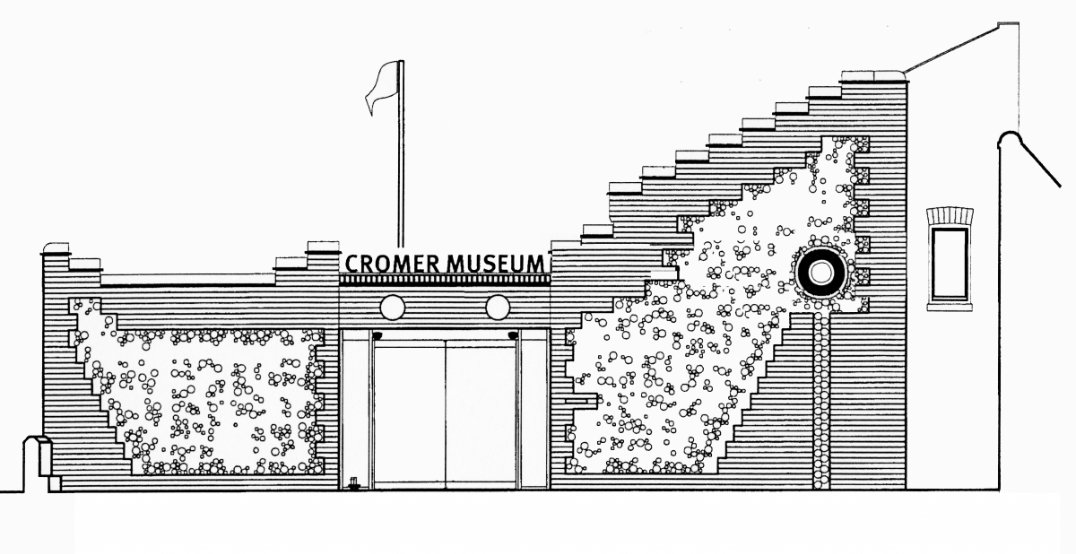Margaret and Harold Hems
Margaret and Harold Hems are celebrated for their groundbreaking discovery of the West Runton mammoth. Their passion for fossil hunting and dedication to natural history not only brought them international recognition but also left a lasting legacy for future generations.
 Margaret Hems in 2015, when a mammoth model walked the West Runton beachHarold Hems was born in Sheffield in 1921. He was the son of a disabled World War I soldier and a Sheffield girl. Academic prowess earned him a place at grammar school at the age of 10. Unable to afford to attend university, Harold initially worked for the Post Office before being conscripted in 1941 as a frontline wireless operator with the Royal Corps of Signals. Already a keen and talented natural historian, after the war he trained as a teacher of biology, but soon switched to teaching maths. He was an extremely talented natural history photographer and was a Fellow of the Royal Photographic Society. He also served on the Selection Panel of the RPS for many years and gained the Society's Exhibition Medal.
Margaret Hems in 2015, when a mammoth model walked the West Runton beachHarold Hems was born in Sheffield in 1921. He was the son of a disabled World War I soldier and a Sheffield girl. Academic prowess earned him a place at grammar school at the age of 10. Unable to afford to attend university, Harold initially worked for the Post Office before being conscripted in 1941 as a frontline wireless operator with the Royal Corps of Signals. Already a keen and talented natural historian, after the war he trained as a teacher of biology, but soon switched to teaching maths. He was an extremely talented natural history photographer and was a Fellow of the Royal Photographic Society. He also served on the Selection Panel of the RPS for many years and gained the Society's Exhibition Medal.
Margaret Barber was born in 1932, in Dronfield, Derbyshire. The younger of two children, she enjoyed a happy childhood and displayed a talent for craft and needlework. She also had a great love for the natural world. Margaret trained as a nursery assistant and met Harold on a bus whilst they were travelling to their respective places of work.
They married on July 29, 1955, and began their life together near Dronfield.
 Margaret Hems works on the emerging mammoth pelvisIn 1959, the Hems family moved to Norfolk to be closer to the sea. Harold became Head of Mathematics at Cromer Secondary Modern School, a position he held until his retirement in 1981. The couple commissioned a bungalow in Renwick Park, West Runton, where they lived for nearly 60 years. Margaret was active in the local church, participating in Sunday school, the Women's Institute, and the Runton Ladies social group. Margaret returned to work as a welfare assistant at Sheringham Primary School, where she remained until she retired.
Margaret Hems works on the emerging mammoth pelvisIn 1959, the Hems family moved to Norfolk to be closer to the sea. Harold became Head of Mathematics at Cromer Secondary Modern School, a position he held until his retirement in 1981. The couple commissioned a bungalow in Renwick Park, West Runton, where they lived for nearly 60 years. Margaret was active in the local church, participating in Sunday school, the Women's Institute, and the Runton Ladies social group. Margaret returned to work as a welfare assistant at Sheringham Primary School, where she remained until she retired.
The couple's passion for natural history extended to photography, and they spent their retirement travelling in their motorhome around Europe, capturing wildlife through their lenses. Nearer home, they walked the north Norfolk beaches looking for prehistoric artefacts.
Their most significant find came on December 13, 1990, during a fossil-hunting expedition on West Runton beach. Following a storm that exposed more of the fossil riverbed, Margaret spotted a bone, part of a mammoth or elephant's pelvis, sticking out of the cliff. Over four days of secret digging, the couple unearthed the pelvis and an anklebone, which hinted at the magnitude of their find. They made contact with the Cromer Museum's curator, Martin Warren, who assisted, without going public, and correctly followed procedures to obtain more of the mammoth. Museum mega fauna specialist, Professor Tony Stuart, was brought in to help and advise.
Subsequent storms revealed more bones, leading to an exploratory excavation in January 1992 and a full excavation in 1995. The West Runton mammoth was a Steppe Mammoth (Mammuthus trogontherii) aged around 42 years. It was found to be 85% complete and the most intact skeleton of its species ever discovered. Standing four metres tall and weighing ten tonnes, the mammoth provided invaluable insights into Britain's environment before the last Ice Age.
 Margaret and Harold Hems on the mammoth excavation site in 1995.The discovery propelled the Hems into the international spotlight. They led tours, gave talks, and appeared on radio and television to share their findings. Margaret's favourite aspect of the discovery was its ability to inspire young natural history enthusiasts. As she once said, " Children love dinosaurs, but the children here have their own treasure."
Margaret and Harold Hems on the mammoth excavation site in 1995.The discovery propelled the Hems into the international spotlight. They led tours, gave talks, and appeared on radio and television to share their findings. Margaret's favourite aspect of the discovery was its ability to inspire young natural history enthusiasts. As she once said, " Children love dinosaurs, but the children here have their own treasure."
Dr. Tori Herridge, an evolutionary biologist at the Natural History Museum, paid tribute to Margaret, describing her as a warm and generous person and a great storyteller with a sharp mind. Margaret's dedication to education and public engagement ensures that the West Runton mammoth will continue to inspire future generations.
Margaret and Harold Hems' discovery of the West Runton mammoth was not just a scientific milestone but a testament to their passion for natural history and education. Their story is one of curiosity, perseverance, and a deep love for the natural world. Through their efforts, they have left an indelible mark on the field of palaeontology and the hearts of those who knew them.




